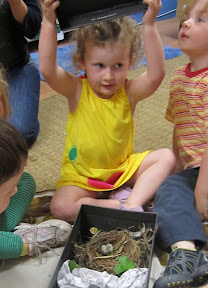Spring bird sightings bring reflection on conference sessions
By Peggy Ashbrook
Posted on 2011-05-21
 Spring migration brings additional bird species back to their nesting range and in numbers that children can easily observe. There have been plenty of American Robins pulling up worms from the rain-soaked ground. And the children discovered a Robin’s nest in the shrubby tree on the playground, not under our noses but just above them. Your class can become citizen scientists by sending information about the nests they find to NestWatch, a nest-monitoring project developed by the Cornell Lab of Ornithology in collaboration with the Smithsonian Migratory Bird Center, and funded by the National Science Foundation. Begin by having your students observe and draw the nest without disturbing it.
Spring migration brings additional bird species back to their nesting range and in numbers that children can easily observe. There have been plenty of American Robins pulling up worms from the rain-soaked ground. And the children discovered a Robin’s nest in the shrubby tree on the playground, not under our noses but just above them. Your class can become citizen scientists by sending information about the nests they find to NestWatch, a nest-monitoring project developed by the Cornell Lab of Ornithology in collaboration with the Smithsonian Migratory Bird Center, and funded by the National Science Foundation. Begin by having your students observe and draw the nest without disturbing it.The interest in bird nest building grew when a child brought in a nest with eggs that had been downed by storm winds, and unattended by the parents for days. (Note that the US Fish and Wildlife Service administers the Migratory Bird Treaty Act and that states also regulate possession of nests.) We looked at it closely but did not touch it.

Then we tried building a nest using sticks, grass, and pottery clay. The almost three-year-olds loved getting into the clay, and found the nest building too difficult to work on for very long.
It’s amazing how many species of birds can be seen in one location. Lisa Gardiner wrote about looking for birds in San Francisco’s Golden Gate Park with a team from BirdSleuth who were leading an NSTA National Conference workshop called Exploring Birds and Citizen Science. Birds hadn’t caught her attention the first time she walked the route on her way to the workshop, “Yet once I was looking for birds they seemed to be everywhere.” National and area NSTA conferences are great places to get support for teaching science in early childhood, learn some fascinating science content to share with your students, and to get “how-to” tips for teaching. I always come home with new resources—materials, websites, and contacts—and renewed enthusiasm. Maybe one of my or your students will be inspired like Noah Strycker who wrote about his experience studying Adelaide penguins in the Antarctic in his book, “Among Penguins: A Bird Man in Antarctica.” Strycker became interested in bird watching when an elementary school teacher pointed out chickadees and grosbeaks on a bird feeder outside the classroom window. Read his blog to keep up with his travels along the Pacific Crest Trail which he kicked off this week, on May 19, 2011. I wonder what birds he will see?
Peggy
Disclaimer: The views expressed in this blog post are those of the author(s) and do not necessarily reflect the official position of the National Science Teaching Association (NSTA).



